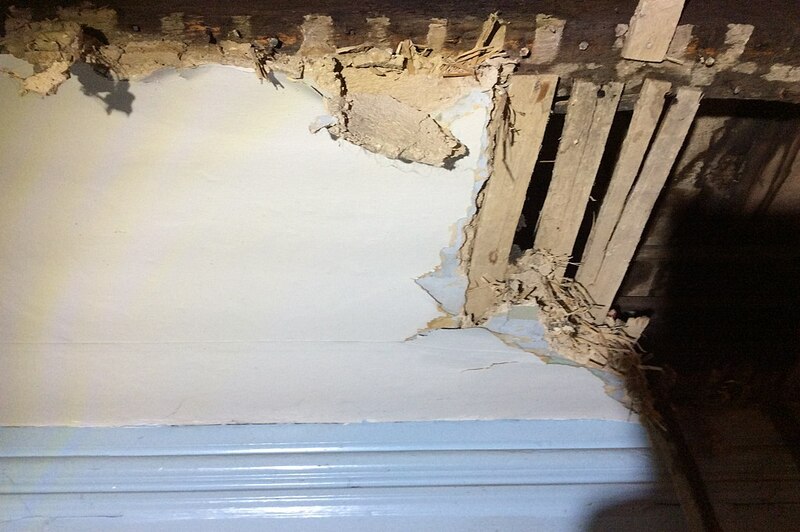Patch up the area and install a new plaster sheet. That’s the best way how to repair water damaged lath ceiling.
Leaving water-damaged lath and plaster may cause safety risks for you and your loved ones. That’s why you must repair the damage once you notice it.

This guide will show you the best methods for repairing your ceiling.
What Are Lath And Plaster?
Lath and plaster are common finishings you can find on ceilings or walls. They are more common in old houses, especially those built between the 18th and 20 centuries.
Ancestral homes usually use lath and plaster for their ceilings, that’s why you must check if they’re in good condition due to their age.
Laths are thin, vertical pieces of wood that form the framework of your structure. These pieces are placed 6mm apart to make room for the plaster.
The plaster goes on top of the lath, and they are the primary layer of your ceiling. You can install three plaster layers to make your wall strong.
These two parts work together to make your ceiling sturdy and beautiful.
Causes Of Water Damage To Lath Ceiling
Old homes usually use lath and plaster ceilings, so they’ve been exposed to different types of weather. Water damage is one of the biggest concerns you can have with your materials.
Plaster is brittle, so any excess water or vibrations can cause it to break. It may separate from the lath and collapse.
Luckily, this part is quick to replace and you only need minimal tools. Here is an informative guide on how to fix water damaged plaster ceiling.
Damage to the laths may be more severe. You will need to do rigorous D.I.Y. work or ask for the help of professionals.
Signs Of Water Damage In Lath And Plaster Ceiling
The best way to spot water damage in your lath ceiling is to look at the paint. If there are any bubbles or flaking that means there’s moisture buildup in your ceiling.
Paint usually shows the first signs of water damage as it flakes with minimal exposure to water. That’s why you must apply some coating to your ceiling.
It may be tempting to leave your lath to dry naturally, but this process may take time. Mold may start growing if you leave the moisture unattended.
Methods To Repair Water Damaged Lath
Lath and plaster homes are quite sturdy, and they may not need much attention with water damage. However, there are some helpful D.I.Y. projects you can do to reinforce your ceiling.
1. Skimming
One quick way to cover the blemishes on your ceiling is by skimming. You just need to make a sturdy plaster mix and apply a coat to your ceiling.
Lime-based plaster works best for this project. You must time this task well as the mixture dries quickly.
Apply several to make the plaster sturdy enough.
2. Put galvanized mesh
This method is a modern way to repair your water-damaged lath. If the inner parts of your ceiling are exposed you can install Expanded Metal Lathing (EML).
You need to nail the EML between your lathing studs, then apply a plaster layer over it.
This is a popular method with people who like preserving heritage homes, as the finish looks similar to the original lath and plaster ceiling.
3. Use plasterboard
A quicker way to fix your ceiling is by installing prefabricated sheet plasterboard on your water-damaged lath. Finish off with plasterboard nails.
This method can fix your ceiling, but it isn’t best for conserving the original structure of your ancestral home.
The plaster on your ceiling may develop mold if it’s left unattended for a long time. Here is an informational guide on how to seal water damaged plaster with molds.
Cost Of Repairing Lath Ceiling
Hiring professionals can be a better solution to fixing your lath and plaster ceiling. They have more experience and sophisticated tools to do the job properly.
However, you will need to pay more when you hire professionals. You will need to spend about $300 to fix a medium hole in your ceiling.
The location, cause of damage, and need for repainting can affect how much your total cost will be.
When Should You Replace The Ceiling?
If the damage to your ceiling isn’t severe, you should try to leave it alone as much as possible. Preserving the lath and plaster on your old home can add to its value and aesthetic.
However, once there are safety issues like falling boards or toxic mold, then you must have the lath in your ceiling replaced.
You will spend $15 per square foot to replace your whole ceiling; that’s why you must constantly check the lathing to avoid this high cost.
You may want to install drywall over your lath and plaster ceiling. It will cover any bulges or stains accumulated through the years, and it will protect your old ceiling.
Remember to always apply some coats of paint to protect your ceiling from peels and cracks. The coating will also even out the texture of your lath and plaster.
Conclusion
Ceilings from old homes are beautiful and sturdy. However, you must be ready to make some repairs to water damage.
You can preserve the original structure of your home when you know how to repàir water damaged lath ceiling. Protect your ancestral home from aging and decay.
